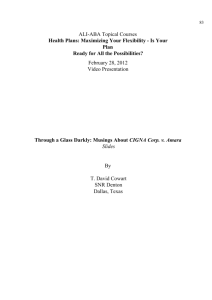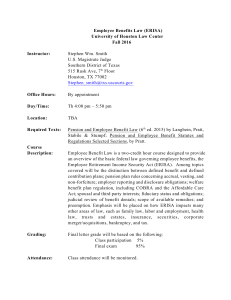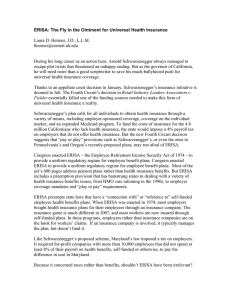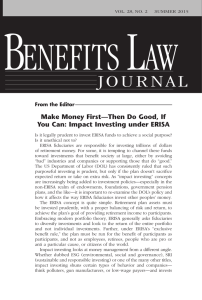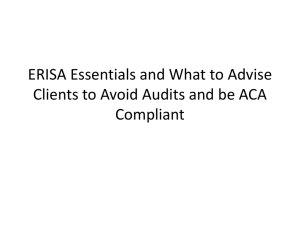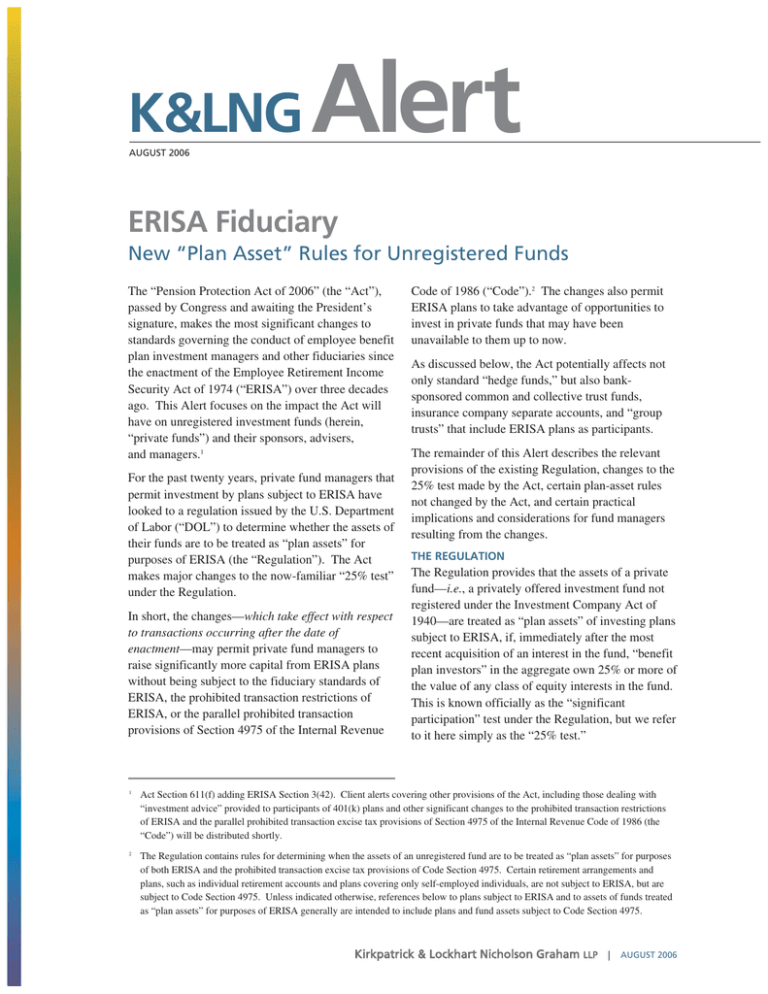
K&LNG
AUGUST 2006
Alert
ERISA Fiduciary
New “Plan Asset” Rules for Unregistered Funds
The “Pension Protection Act of 2006” (the “Act”),
passed by Congress and awaiting the President’s
signature, makes the most significant changes to
standards governing the conduct of employee benefit
plan investment managers and other fiduciaries since
the enactment of the Employee Retirement Income
Security Act of 1974 (“ERISA”) over three decades
ago. This Alert focuses on the impact the Act will
have on unregistered investment funds (herein,
“private funds”) and their sponsors, advisers,
and managers.1
For the past twenty years, private fund managers that
permit investment by plans subject to ERISA have
looked to a regulation issued by the U.S. Department
of Labor (“DOL”) to determine whether the assets of
their funds are to be treated as “plan assets” for
purposes of ERISA (the “Regulation”). The Act
makes major changes to the now-familiar “25% test”
under the Regulation.
In short, the changes—which take effect with respect
to transactions occurring after the date of
enactment—may permit private fund managers to
raise significantly more capital from ERISA plans
without being subject to the fiduciary standards of
ERISA, the prohibited transaction restrictions of
ERISA, or the parallel prohibited transaction
provisions of Section 4975 of the Internal Revenue
Code of 1986 (“Code”).2 The changes also permit
ERISA plans to take advantage of opportunities to
invest in private funds that may have been
unavailable to them up to now.
As discussed below, the Act potentially affects not
only standard “hedge funds,” but also banksponsored common and collective trust funds,
insurance company separate accounts, and “group
trusts” that include ERISA plans as participants.
The remainder of this Alert describes the relevant
provisions of the existing Regulation, changes to the
25% test made by the Act, certain plan-asset rules
not changed by the Act, and certain practical
implications and considerations for fund managers
resulting from the changes.
THE REGULATION
The Regulation provides that the assets of a private
fund—i.e., a privately offered investment fund not
registered under the Investment Company Act of
1940—are treated as “plan assets” of investing plans
subject to ERISA, if, immediately after the most
recent acquisition of an interest in the fund, “benefit
plan investors” in the aggregate own 25% or more of
the value of any class of equity interests in the fund.
This is known officially as the “significant
participation” test under the Regulation, but we refer
to it here simply as the “25% test.”
1
Act Section 611(f) adding ERISA Section 3(42). Client alerts covering other provisions of the Act, including those dealing with
“investment advice” provided to participants of 401(k) plans and other significant changes to the prohibited transaction restrictions
of ERISA and the parallel prohibited transaction excise tax provisions of Section 4975 of the Internal Revenue Code of 1986 (the
“Code”) will be distributed shortly.
2
The Regulation contains rules for determining when the assets of an unregistered fund are to be treated as “plan assets” for purposes
of both ERISA and the prohibited transaction excise tax provisions of Code Section 4975. Certain retirement arrangements and
plans, such as individual retirement accounts and plans covering only self-employed individuals, are not subject to ERISA, but are
subject to Code Section 4975. Unless indicated otherwise, references below to plans subject to ERISA and to assets of funds treated
as “plan assets” for purposes of ERISA generally are intended to include plans and fund assets subject to Code Section 4975.
Kirkpatrick & Lockhart Nicholson Graham LLP |
AUGUST 2006
“Benefit plan investors” are defined to include not
only plans subject to ERISA and Code Section 4975
(such as individual retirement accounts and plans
covering self-employed individuals), but also other
employee benefit plans not subject to those statutes.
The latter category includes a wide variety of
employee benefit plans, such as governmental plans,
church plans, and foreign plans.
Former 25% Test—Example 1
Private fund (Fund A) has a single class of equity
interests and total assets of $10 million. ERISA plans
hold equity interests in Fund A having a value of
$2 million; government plans hold $2 million; nonplan investors hold the remaining $6 million. Since
benefit plan investors, as defined, hold 25% or more
of the equity interests in Fund A (in this case 40%),
the assets of Fund A are treated as “plan assets.”
The term “benefit plan investor” also includes a
private fund or other entity whose assets are treated
as “plan assets.” Thus, Fund A in Example 1 would
itself be considered a “benefit plan investor” if it
were to invest in another fund.
Former 25% Test—Example 2
Fund A invests in another private fund (Fund B).
Fund B has a single class of equity interests and total
assets of $10 million. Fund A holds equity interests
in Fund B with a value of $2 million; foreign plans
hold $2 million of equity interests in Fund B; nonplan investors hold the remaining $6 million. Since
benefit plan investors, including Fund A and the
foreign plans, hold 25% or more of the equity
interests in Fund B (in this case, 40%), the assets of
Fund B are treated as “plan assets.”
The Regulation also includes a special rule that
provides that the assets of certain other types of
unregistered funds in which ERISA plans may hold
interests always are treated as “plan assets,”
regardless of the percentage of equity interests held
by “benefit plan investors.” These include common
or collective trust funds of banks, separate accounts
of insurance companies (if maintained in connection
with obligations of the insurance companies that
vary according to the performance of investments
held in the separate accounts), and “group trusts”
for corporate and governmental employee benefit
plans described in Revenue Ruling 81-100,3
regardless of the identity of the sponsor or manager
of the group trust.
Former 25% Test—Example 3
Investment adviser (IA) sponsors and manages a
group trust fund (Group Trust) for employee benefit
trusts described in Revenue Ruling 81-100 (and
which qualify under applicable securities law
exemptions). The Group Trust has total assets of
$10 million. ERISA plans hold equity interests with
a value of $2 million; government plans hold the
remaining $8 million. The assets of the Group Trust
are treated as “plan assets” under the special rule of
the Regulation.
Former 25% Test—Example 4
Bank maintains a common trust fund (CTF) with
total assets of $10 million. The CTF consists of
trusts (for which Bank acts as trustee) established by
or for tax-exempt organizations described in Code
Section 501(c). Trusts of “voluntary employees’
beneficiary associations” subject to ERISA
(“VEBAs”)4 hold CTF interests with a value of
$2 million; trusts of other tax-exempt organizations
that are not employee benefit plans hold the
remaining $8 million. The assets of the CTF are
treated as “plan assets” under the special rule of
the Regulation.
Another application of the “plan assets” concept
involves insurance company general accounts. A
1993 Supreme Court decision held that general
account assets not backing contracts providing for
guaranteed benefits could be considered “plan
assets,” thereby subjecting the insurance company to
ERISA in regard to the management of those assets.
The DOL has indicated that only the portion of an
insurance company general account’s equity
investment in a private fund or other entity that
represents “plan assets” need be taken into account
in the computation of the fund’s 25%.
THE NEW “25% TEST”
The Act states that the term “plan assets” is to be
defined by DOL regulations. The Act also
specifically provides, however, that the assets of an
entity are not to be treated as “plan assets” unless the
entity passes (or fails, depending on your point of
view) a newly revised 25% test described below:
3
Revenue Ruling 81-100 has been clarified and modified by Revenue Ruling 2004-67.
4
VEBAs are employee welfare benefit plans exempt from taxation under Code Section 501(c)(9).
2
Kirkpatrick & Lockhart Nicholson Graham
LLP
|
AUGUST 2006
First, only plans subject to ERISA or Code Section
4975 are to be taken into account.
Revised 25% Test—Example 1
In Example 1 above, the assets of Fund A would not
be treated as plan assets because ERISA plans hold
less than 25% (in that case, 20%) of the interests.
CONTINUING RULES
Other rules affecting the status of investment
vehicles under ERISA are not changed by the Act.
Among those worth noting are the following:
■
As is the case under the existing Regulation,
the revised 25% test is to be applied to each
“class” of equity interests in a fund (a term not
defined in either the Act or the Regulation).
Moreover, any interests held by the fund
manager (or an affiliate), other than through a
benefit plan investor, are to be disregarded in
making the computation.
■
The Act makes no changes to existing
statutory exclusions applicable to mutual funds
and other investment companies registered
under the Investment Company Act of 1940.
The assets of these funds will continue not to
be treated as plan assets, and mutual fund
advisers will not be considered ERISA
fiduciaries solely because ERISA plans are
investors or shareholders in such funds.
■
The Act does not change the rules applicable
to insurance company general account
investments in funds. If anything, the Act’s
requirement—that only the proportion of a
plan-asset fund or other entity that is
attributable to ERISA plans is to be counted in
the computation of the 25% test for another
fund in which the first fund invests—is
consistent with the view that the proportionate
counting of “plan assets” in insurance
company general accounts should include
plans subject to ERISA and Code Section
4975 only.
Second, only that portion of the assets of a planassets fund that is attributable to investing ERISA
plans is taken into account for purposes of applying
the 25% test to another private fund in which the
first fund invests.
Revised 25% Test—Example 2
Assume the same facts as described in Examples
1 and 2 above, except that ERISA plans hold equity
interests in Fund A with a value of $3 million,
representing 30% of the total interests in Fund A.
Fund A invests $2 million in Fund B, which has a
single class of equity interests and total assets of
$10 million. Other equity interests in Fund B are
held by foreign plans ($2 million) and non-plan
investors ($6 million). Under the 25% test as
revised by the Act, the assets of Fund A are treated
as “plan assets,” and Fund A is the only benefit plan
investor in Fund B (i.e., the foreign plans are no
longer considered benefit plan investors). Moreover,
Fund B would be required to include for purposes of
its 25% test only that portion of Fund A’s investment
that is attributable to ERISA plan investors (30% of
$2 million), or $600,000. Since benefit plan
investors (i.e., the portion of Fund A attributable to
ERISA plans) hold only 6% of the equity interests in
Fund B ($600,000 of $10 million in Fund A), the
assets of Fund B are not treated as “plan assets.”
Finally, the revised 25% test applies to “any entity.”
None of the Act, the Regulation, or ERISA defines
the term “entity.” It is reasonably clear from the
Regulation as a whole, however, that the term
contemplates investment vehicles and arrangements
of all kinds, regardless of legal form or structure.
Revised 25% Test—Examples 3 and 4
Under this interpretation,5 the assets of the Group
Trust in Example 3 and the CTF in Example 4
above would not be considered “plan assets”
because, in both cases, ERISA plans hold less than
25% of the equity interests in the fund (in each of
those cases, 20%).
5
3
PRACTICAL IMPLICATIONS
A determination that fund assets are “plan assets” for
ERISA purposes has critical regulatory ramifications
for the fund manager. Most importantly, the
manager of a plan-asset fund is considered a
“fiduciary” under ERISA with respect to each of the
investing ERISA plans.
An ERISA fiduciary is expected to conform with
ERISA’s fiduciary standards and prohibited
transaction restrictions in managing fund
investments and transactions. Investing ERISA
plans generally will expect the manager to
acknowledge its fiduciary status and provide
reasonable assurances that the manager will conform
Although the scope of its rulemaking authority is not completely clear, it appears the DOL may have at least some residual authority
to interpret or define the term "plan assets." Consequently, private fund managers should be watchful for any clarifications or refinements of the subject the DOL may propose in the future.
Kirkpatrick & Lockhart Nicholson Graham
LLP
|
AUGUST 2006
with applicable ERISA standards. Managers of
“plan-asset” private funds also may be expected to
represent that they meet the requirements of a
“qualified professional asset manager” (“QPAM”)
for purposes of a DOL class exemption that permits
a plan-asset fund to engage in various types of
transactions that otherwise might be prohibited.
Moreover, ERISA’s regulatory regime will govern
the management of the fund, even though many of
its investors may not be ERISA plans.
Many private fund managers up to now have sought
to avoid the complexities associated with ERISA
compliance and other practical difficulties by
voluntarily restricting investments by employee
benefit plans of all kinds to less than 25% of their
funds. Many others have designed their funds to
become subject to and compliant with ERISA, and
thereby increase investments by ERISA and other
plans. As a result of the changes described above,
however, all managers will have the opportunity
to rethink their business and regulatory compliance
strategies.
Clearly, the Act’s principal impact will be to relieve
a potentially significant number of unregistered fund
managers from initial or continued compliance with
ERISA’s fiduciary duty and prohibited transaction
requirements. Managers that have restricted plan
investments in order to avoid the application of
ERISA will be in a position to permit potentially
substantial additional investments by plans while
continuing to avoid the application of ERISA.
Managers of funds that have been subject to
ERISA to this point have a number of practical
issues to address:
■
How does the revised 25% test apply to and
affect my fund(s)?
■
If the assets of my funds are no longer treated
as ERISA plan assets, do I terminate the
ERISA compliance procedures that have been
adopted and followed to this point (including,
e.g., compliance with the QPAM exemption
and other prohibited transaction exemptions)?
■
If so, how and when should those procedures
be changed?
■
How and when do I inform fund investors
about the changes?
■
What changes, if any, should be made to the
fund’s governing documents (offering
memoranda, subscription agreements) or
agreements with third parties (prime
brokerage agreements, etc.)?
4
■
Do I have adequate information in regard to
the proportionate ownership by ERISA and
Code Section 4975 plans of fund-of-funds
investors in my fund and can I monitor such
information accurately over time?
A practical consideration that should not be
overlooked in the transition process relates to the
continued need to monitor fund investors
continuously and accurately. The Act does not
change the requirement that the 25% test be applied
on an ongoing basis, after each initial or additional
investment in the fund. Thus, the need to monitor
changes in the identity and holdings of fund
investors so as to ensure the 25% test is computed
accurately continues under the revised rules. This
can be particularly challenging in the case of “open
end” funds that permit investments and redemptions
on a periodic, ongoing basis. The task of
monitoring is even greater where eligible investors
include other funds (e.g., funds-of-funds) whose
investors include ERISA plans. In all these cases,
direct and indirect holdings of fund interests by
ERISA plans—and the results of the 25% test—
potentially may vary on a day-to-day basis.
Another important consideration relates to
governmental plan investors. These plans are
regulated by state and local laws that in many cases
refer to or may be modeled on ERISA and/or the
Regulation. The extent to which the Act affects
existing rules applicable to these investors should be
assessed on a case-by-case basis.
*
*
*
The lawyers of our Hedge Fund and ERISA
fiduciary practice groups have substantial
experience assisting unregistered fund clients with
ERISA compliance and related matters, and would
be glad to discuss these and other implications of the
new rules.
This Alert is a general summary of some of the
Act’s most important implications for managers of
investment vehicles in which ERISA plans invest.
Each manager should assess the Act’s impact on
its own fund(s) in light of the particular facts
and circumstances.
If you have any questions or need additional
information, please contact a member of the
Hedge Fund or ERISA fiduciary practice groups
listed on the next page.
Kirkpatrick & Lockhart Nicholson Graham
LLP
|
AUGUST 2006
Members of the ERISA Fiduciary Group and their telephone numbers and email addresses are listed
below. For more information you may also visit our website at www.klng.com.
ERISA FIDUCIARY
LOS ANGELES
William P. Wade
310.552.5071
wwade@klng.com
WASHINGTON
Catherine S. Bardsley
David E. Pickle
William A. Schmidt
202.778.9289
202.778.9887
202.778.9373
cbardsley@klng.com
dpickle@klng.com
william.schmidt@klng.com
If you have questions or would like more information about K&LNG’s Hedge Fund Practice, please contact one of our lawyers listed below, or send general inquiries via e-mail to hedgefunds@klng.com.
HEDGE FUND
BOSTON
Mark P. Goshko
Nicholas S. Hodge
617.261.3163
617.261.3210
mgoshko@klng.com
nhodge@klng.com
LONDON
Philip J. Morgan
+44.20.7360.8123
pmorgan@klng.com
NEW YORK
Beth R. Kramer
Richard D. Marshall
212.536.4024
212.536.3941
bkramer@klng.com
rmarshall@klng.com
SAN FRANCISCO
David Mishel
Mark D. Perlow
415.249.1015
415.249.1070
dmishel@klng.com
mperlow@klng.com
WASHINGTON
Cary J. Meer
Robert H. Rosenblum
202.778.9107
202.778.9464
cmeer@klng.com
rrosenblum@klng.com
www.klng.com
BOSTON
■
DALLAS
■
HARRISBURG
■
LONDON
■
LOS ANGELES
■
MIAMI
■
NEWARK
■
NEW YORK
■
PALO ALTO
■
PITTSBURGH
■
SAN FRANCISCO
■
WASHINGTON
Kirkpatrick & Lockhart Nicholson Graham (K&LNG) has approximately 1,000 lawyers and represents entrepreneurs, growth and middle market companies, capital markets participants, and leading FORTUNE 100 and FTSE 100 global corporations nationally and internationally.
K&LNG is a combination of two limited liability partnerships, each named Kirkpatrick & Lockhart Nicholson Graham LLP, one qualified in Delaware,
U.S.A. and practicing from offices in Boston, Dallas, Harrisburg, Los Angeles, Miami, Newark, New York, Palo Alto, Pittsburgh, San Francisco and
Washington and one incorporated in England practicing from the London office.
This publication/newsletter is for informational purposes and does not contain or convey legal advice. The information herein should not be used or relied
upon in regard to any particular facts or circumstances without first consulting a lawyer.
Data Protection Act 1988—We may contact you from time to time with information on Kirkpatrick & Lockhart Nicholson Graham LLP seminars and with
our regular newsletters, which may be of interest to you. We will not provide your details to any third parties. Please e-mail london@klng.com if you
would prefer not to receive this information.
© 2006 KIRKPATRICK & LOCKHART NICHOLSON GRAHAM LLP. ALL RIGHTS RESERVED.


